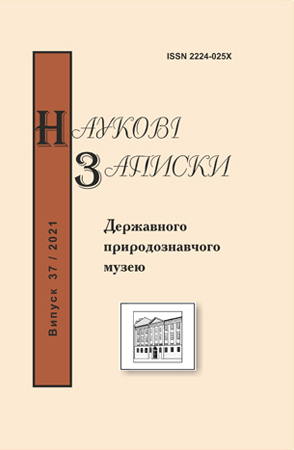Main
/
/
Shcherbachenko O.I.
Resistance of mosses Bryum аrgenteum Hedw. and Funaria hygrometrica Hedw. to the effect of heavy metal ions // Proc. of the State Nat. Hist. Mus. - Lviv, 2021. - 37. - P. 115-122 DOI: https://doi.org/10.36885/nzdpm.2021.37.115-122 Key words: Mosses, tolerance, heavy metal ions vegetative and generative clones superoxide dismutase, catalase The tolerance of vegetative and generative clones of mosses of B. argenteum and F. hygrometrica from background and anthropogenically transformed territories to the influence of heavy metal ions was experimentally investigated. It has been established that the increase of the resistance of moss to the influence of heavy metal ions occurs through the activation of growth and physiological-biochemical processes. The level of adaptability of mosses depended on the concentration of toxic ions, the growing environment, and the vital strategy of the moss. It was established that with increasing concentration of lead ions in the environment, the generative propagation of mosses was suppressed, the percentage of germination of spores decreased, the differentiation of protonema and the speed of gametophore development slowed down, the size of cells, number and size of leaves decreased. Obviously, under the influence of elevated lead concentrations, significant changes in metabolic processes occurred in moss cells and showed signs of xeromorphism. The results of the analysis of the rates of gametophyte differentiation and the state of the antioxidant system of mosses B. argenteum and F. hygrometrica, depending on the content of heavy metal ions, show different adaptive capacity. Changes in the rate of gametophyte differentiation and the activity of superoxide dismutase and catalase antioxidant enzymes have been shown to be sensitive biomarkers of the resistance of generative and vegetative moss clones to heavy metal contamination of man-made territories.
Resistance of mosses Bryum аrgenteum Hedw. and Funaria hygrometrica Hedw. to the effect of heavy metal ions // Proc. of the State Nat. Hist. Mus. - Lviv, 2021. - 37. - P. 115-122 DOI: https://doi.org/10.36885/nzdpm.2021.37.115-122 Key words: Mosses, tolerance, heavy metal ions vegetative and generative clones superoxide dismutase, catalase The tolerance of vegetative and generative clones of mosses of B. argenteum and F. hygrometrica from background and anthropogenically transformed territories to the influence of heavy metal ions was experimentally investigated. It has been established that the increase of the resistance of moss to the influence of heavy metal ions occurs through the activation of growth and physiological-biochemical processes. The level of adaptability of mosses depended on the concentration of toxic ions, the growing environment, and the vital strategy of the moss. It was established that with increasing concentration of lead ions in the environment, the generative propagation of mosses was suppressed, the percentage of germination of spores decreased, the differentiation of protonema and the speed of gametophore development slowed down, the size of cells, number and size of leaves decreased. Obviously, under the influence of elevated lead concentrations, significant changes in metabolic processes occurred in moss cells and showed signs of xeromorphism. The results of the analysis of the rates of gametophyte differentiation and the state of the antioxidant system of mosses B. argenteum and F. hygrometrica, depending on the content of heavy metal ions, show different adaptive capacity. Changes in the rate of gametophyte differentiation and the activity of superoxide dismutase and catalase antioxidant enzymes have been shown to be sensitive biomarkers of the resistance of generative and vegetative moss clones to heavy metal contamination of man-made territories.
References
- Bashutska U.B. (2006). Suktsesii roslynnosti porodnykh vidvaliv shakht Chervonohradskoho hirnychopromyslovoho raionu. Lviv: RVV NLTU Ukrainy, 180 s. [In Ukrainian]
- Karpinets L.I., Lobachevska O.V., Baranov V.I. (2014). Vplyv briofitiv na vmist makroelementiv ta orhanichnoho Karbonu u tekhnozemakh porodnykh vidvaliv Chervonohradskoho hirnychopromyslovoho kompleksu. Visnyk Kharkivskoho universytetu. Seriia: Biol., 3: 52–58. [In Ukrainian]
- Lakyn H. F. Byometryia. M.: Vysshaia shkola, 1990. 350 s [In Russian]
- Nikolaichuk V.I., Belchhazi V.I., Bilyk P.P. Spetspraktykum z fiziolohii i biokhimii roslyn. Uzhhorod, 2000. 210 s. [In Ukrainian]
- Oboznyi A.Y., Kolupaev Yu.E., Shvydenko N.V., Vainer A.A. Dynamyka aktyvnosty antyoksydantnikh fermentiv pry kross-adaptatsyy prorostkov pshenytsi k hypertermyy y osmotycheskomu shoku // Visn. Khark. nats. ahrarn. un-tu. Ser: Biolohiia. – 2012. – Vyp. 2(26). – S. 71-84. [In Russian]
- Sokhanchak R.R., Lobachevska O.V. (2012). Osoblyvosti vplyvu mokhu Campylopus introflexus (Hedw.) Brid. na vidnovlennia tekhnohennykh substrativ shakhtnykh vidvaliv. Biolohichni Studii / Studia Biologica, 6(1). 101–108. [In Ukrainian]
- Khorkavtsiv Ya.D., Lobachevska O.V. (2011). Osoblyvosti heneratyvnoho rozmnozhennia dominantnoho vydu Barbula unguiculata Hedw. na vidvalakh sirchanoho vydobutku. Naukovi zapysky Ternopilskoho derzhavnoho pedahohichnoho universytetu im. Volodymyra Hnatiuka. Seriia: Biolohiia. 2(47). 150–155. [In Ukrainian]
- Glime J.M. (2006). Bryophyte Ecology. Volume 1. Physiological Ecology. E-book sponsored by Michigan Technological University and the International Association of Bryologists: 1–280. http://www.bryoecol.mtu.edu/ date of application: 02.06.2021
- Glime J.M. (2013). Bryophyte Ecology. Volume 2: Bryological Interaction. Chapter 5–2: Tardigrade reproduction and food. E-book sponsored by Michigan Technological University and the International Association of Bryologists: 281–304. http://www.bryoecol.mtu.edu/ date of application: 02.06.2021
- Longton R.E. (2006). Reproductive ecology of bryophytes: what does it tell us about the significance of sexual reproduction. Lindbergia, 31: 16–23
- Onianwa P.C. Monitoring atmospheric metal pollution: a review of the use of mosses as indicators // Environmental monitoring and assessment volume. – 2001. – 71. – R. 13-50.
- Rabyk, I.V., Lobachevska, O.V., Kyyak, N.Y., Shcherbachenko, O.I. (2018). Bryophytes on the devastated territories of sulphur deposits and their role in restoration of dump substrate. Biosystems Diversity, 26(4), 339–353. [DOI:10.15421/011850]


